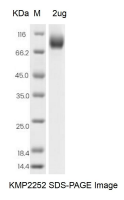Human CD272 Protein, mFc Tag
-
产品编号
KMP2252
-
别名
B和T淋巴细胞衰减因子, B- and T-Lymphocyte Attenuator, CD272
-
规格
- 50ug
- 100ug
- 200ug
| Alias | B和T淋巴细胞衰减因子, B- and T-Lymphocyte Attenuator, CD272 |
| Catalog Number | KMP2252 |
| Product Description | The Human CD272 Protein(KMP2252) is produced in HEK293 Cells and the target gene encoding Lys31-Leu150 is expressed with a mFc tag at the C-terminus. |
| Molecular Name | CD272 |
| Species | Human |
| Host | HEK293 Cells |
| Size | 50ug, 100ug, 200ug |
| Purity | >95% as determined by SDS-PAGE |
| Purification | Affinity purification |
| Endotoxin | <1.0 EU/ug determined by the LAL method |
| Formulation | PBS, pH7.4 |
| Background | B- and T-Lymphocyte Attenuator(BTLA) is a single-pass type I membrane protein containing 1 Ig-like V-type(immunoglobulin-like) domain. BTLA expression is induced during activation of T cells, and BTLA remains expressed on Th1 cells but not Th2 cells. Like PD1 and CTLA4, BTLA interacts with a B7 homolog, B7H4. However, unlike PD-1 and CTLA-4, BTLA displays T-Cell inhibition via interaction with tumor necrosis family receptors(TNF-R), not just the B7 family of cell surface receptors. BTLA is a lymphocyte inhibitory receptor that inhibits lymphocytes during immune response. BTLA also is a ligand for tumor necrosis factor(receptor) superfamily, member 14(TNFRSF14), also known as herpes virus entry mediator(HVEM). BTLA-HVEM complexes negatively regulate T-cell immune responses. |
| SDS-PAGE |  |
| Predicted Molecular Weight | 13.2 kDa |
| Storage Condition | Aliquot and store at -20℃ to -80℃. Avoid repeated freezing and thawing cycles. |
| Shipping Condition | In general, the proteins are provided as lyophilized powder which are shipped at ambient temperature. They are shipped out in dry ice if supplied in liquid form. |
| Uniprot ID | Q7Z6A9 |
| References | 1.Nat. Immunol. 4:670-679 (2003) 2.Biochem. Biophys. Res. Commun. 312:1236-1243 (2003) 3.Nat. Immunol. 6:90-98 (2005) 4.Nat. Immunol. 9:176-185 (2008) 5.J. Immunol. 183:7286-7296 (2009) |
| Function | 1.Inhibitory receptor on lymphocytes that negatively regulates antigen receptor signaling via PTPN6/SHP-1 and PTPN11/SHP-2. 2.May interact in cis (on the same cell) or in trans (on other cells) with TNFRSF14. 3.In cis interactions, appears to play an immune regulatory role inhibiting in trans interactions in naive T cells to maintain a resting state. In trans interactions, can predominate during adaptive immune response to provide survival signals to effector T cells. |





 0
0
